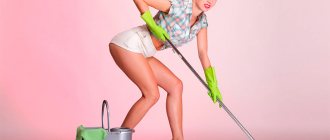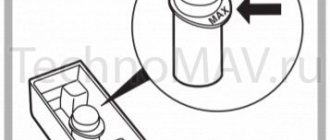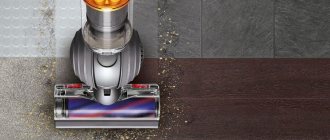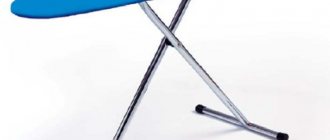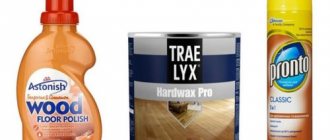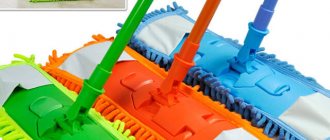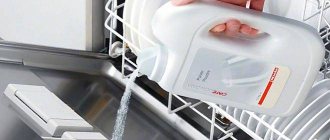Curtains are decorative and functional household curtains on windows. They are one of the main accents of the interior, so they should always be clean and look beautiful. Caring for fabric products is simple.
Most often, there are no problems with washing window decor. But before ironing the curtains, you need to know what the temperature of the iron should be and the procedure for performing the work.
Ironing curtains
This is the most common method of ironing curtains. The iron can be simple or with a steam function. In the first case, you can iron the products only in a horizontal position; to do this, they are laid out on a table or a special board, and in the second case, ironing is done by weight.
Regardless of the type of iron, it has several heating modes for the soleplate, which allows you to choose the temperature mode for different fabrics. In older models there were only 3 temperature adjustment positions, in modern devices there are more of them, so it is possible to more accurately set the required mode.
Adviсe
In order for curtains to look neat and decorate the window, they need to be washed and ironed at least once a month. In addition to observing the temperature regime when ironing, you need to consider a few more points:
- To wash fabric, it is better to choose a delicate cycle with minimal spin or wash it by hand.
- If you don’t have time to iron the curtain after washing, then hang it along its entire length in the bathroom. You can turn on hot water - the steam will quickly remove the wrinkles.
- It is advisable to start ironing the curtains in the coming days. The longer the product sits in the closet, the more difficult it is to remove creases later.
- When ironing by hand, the curtain must be ironed on the wrong side and be sure to lay gauze on top - this will protect the fabric from burning. Ironing should start from the bottom to straighten the most difficult wrinkles. Then they raise the curtains to the middle and only then iron the top.
Ironing rules and temperature conditions for different types of fabric
Before ironing curtains, you need to determine what material they are made of. The required operating mode of the iron will depend on this.
It is recommended to iron only freshly washed curtains. Be sure to pay attention to the condition of the iron sole; it should not be dirty.
Having determined the material from which the curtains are made, having studied its characteristics, select the required mode and begin ironing.
Made from natural materials - linen, cotton, burlap
These are popular materials for curtains, they allow air to pass through well and look beautiful. Linen, cotton, and burlap should be ironed at 170-180 °C, i.e., set the regulator to 3 dots, number III or the inscription cotton and linen.
At the beginning of the process, it is recommended to set the temperature slightly lower than indicated on the product label. You can always add it if necessary. Due to the fact that these are dense natural fabrics, it is necessary to use the steaming or spraying function, or a spray bottle.
Made from silk or wool
Window decor made from silk fabrics adds sophistication and nobility to the room, while window decor from woolen fabrics adds comfort, coziness and softness.
Such materials are difficult to smooth, but steaming or spraying cannot be used for them. The work is performed at an average temperature, for silk it should be 60-80 ° C or 1 point, the inscription nylon or silk.
If you iron through a thin fabric, you can raise the temperature by 10-20 ° C; gauze leaves streaks on the silk. For wool – 100-120 °C, inscription wool. Iron such products only after they are completely dry.
To prevent the silk from stretching, the iron is moved in a vertical direction, and to prevent the wool from being deformed, it should not be moved, but rearranged.
Made from polyester
This is an artificial material, when ironing which special requirements must be observed. If polyester curtains are washed correctly and hung on the curtain rod while wet, they will straighten out on their own under the influence of their own weight.
If the material has dried and remains wrinkled, it can be ironed, do this at a minimum temperature, from the wrong side and cover the curtains with damp gauze.
Photo curtains
This is a modern type of window decoration. An image is applied to the curtains, which retains its original appearance well over a long period of use.
Polyester is most often used to create photo curtains, so the rules for ironing them will be the same. To avoid damaging the photo print, do not use a steamer.
Blackout
The peculiarity of this type of curtains is that they are made of thick fabric, therefore they provide maximum darkening of the room. You don’t have to iron them, just hang them on a curtain rod when damp and they will straighten out on their own. To remove creases and bruises, iron at medium iron temperature and through damp gauze.
From thin delicate fabrics - tulle, veil, organza and others
Decorating a window with such fabrics looks beautiful, they are light and transparent, but they must be ironed carefully, because... they are easy to spoil. You can straighten curtains made of organza and chiffon when they are completely dry.
If you do this while the curtains are wet, they will shrink. Products made from tulle and veils are ironed while they are slightly damp. For delicate fabrics, set the minimum temperature. If such curtains are hung wet on curtains, they will straighten well even without ironing.
Heavy curtain fabrics
If the house has massive and heavy curtains, then a situation often arises when, after ironing them, wrinkles appear again in some places.
To make your work easier, just place the ironing board near the window. First, iron the upper part of the curtain, then hang it on the cornice. Then the remaining lower part is leveled. The heating mode is selected medium or high, depending on the material being worked with.
Made of velvet
This fabric looks beautiful, but it is problematic. After the velvet curtains are washed, they are wrapped in a fabric that absorbs moisture well, gently wrung out, and then dried.
In this case, it is better not to use the steaming mode. Place a soft cloth under the material and iron at medium temperature. The iron is moved in the direction of the pile without strong pressure.
Why a steamer and not an iron?
To completely remove wrinkles that appear after washing with an iron, you need to lay out the curtains, curtains, tulle on a wide, flat surface - this is the only way not to miss a single unevenness. However, not everyone has such conditions, so most often they are dissatisfied with the result.
Using a vertical steamer allows you to:
- iron evenly over the entire area of the item;
- steam it without removing it from the cornice;
- choose a mode suitable for the material from which it is made;
- smooth out ruffles and other decorative elements.
The steamer is ready for use in a few minutes and can continuously generate steam for up to 2 hours (depending on the volume of the boiler), which will be quite enough for working with tulle.
Common mistakes when ironing
There are a number of mistakes that housewives often make when ironing curtains.
You need to know them in order to prevent them from happening in the future:
- Incorrect temperature. If the curtains were purchased in a store, then the label indicates recommendations for the ironing mode. If they are made to order, you must ask the craftsman what fabric they are made of. When the material is unknown, first perform a test ironing in an inconspicuous place.
- Steaming. It is not suitable for all fabrics. Delicate materials cannot be steamed, because... they are easily deformed and lose their original appearance.
- Smoothing curtains with rhinestone embroidery on the front side. This can only be done from the inside out, otherwise the rhinestones will stick to the iron and the embroidery will lose its relief.
- Ironing without lining. If you iron them on the front side of the curtains without a lining, then waves and shine appear on the material, and the likelihood of burning through the fabric also increases.
Professional steamer - what are the advantages?
This type of equipment is mainly used in hotels, shops, studios, curtain salons - where there are large volumes and there are time restrictions. Moreover, they can be used by both a professional master and an amateur.
Professional steam generators really differ from household ones for the better, although they cost an order of magnitude more.
What are the main advantages of these units?
- Higher power – from 2000 W and steam intensity from 70 g/min.
- Boiler steam generation system. Under pressure, steam penetrates fabric fibers easier and deeper.
- Larger water tank volume 3 – 3.5 liters. In addition, most models are equipped with a refueling function.
- With such a large amount of water in the tank, the device heats it up in 30 - 45 seconds.
- Long continuous work: on average 2 hours or more.
- Versatility. Typically, such steamers can also be used as steam cleaners due to the high temperatures of the steam produced.
- It is more convenient to work with a hose of at least 2 m and a cord of about 5 meters.
- Reliable housing that prevents the device from overheating even during long-term operation.
Most manufacturers producing household models have professional steamers.
These are the brands “Kärcher” (Germany), “Grand Master” (Russia), “Sauber” (Sweden), “MIE” (Italy), “Philips” (Netherlands) and many others.
A steam generator is a really necessary thing, and not just another trinket for the home.
This device will become a reliable assistant on the way to perfectly ironed curtains. Regardless of which of the above models you choose!
All of the steamers listed have many positive reviews from their owners.
Steamer - what is it and the purpose of the device
A steamer is a modern device used for ironing various fabric products. Such a device has a water tank, a heating element, a hose and various nozzles. When water is heated, steam is generated, it is applied to the fabric and its structure is leveled.
Functionality
The main task of the steamer is ironing fabric products. In addition, such a device can be used to remove dust and allergens from clothes, to get rid of unpleasant odors, to clean toys, upholstery, etc.
Vertical steamer: what to look for when choosing
What characteristics will allow you to distinguish a good vertical curtain steamer from one that may disappoint? There are several of them.
Any textile can be processed – of any design and shape.
- Steam intensity
The higher the better, ranging from 40 to 140 g/min. At lower intensity, the quality of work will decrease proportionally.
Optimal from 1600 to 2600 W. The higher the power, the faster the water heats up. In addition, a device with a higher rating is guaranteed to withstand long-term continuous use.
The interval from the moment water is filled into the tank until the device is ready for operation. Depending on the power, the process takes from 2 to 10 minutes.
The unit eliminates grease stains, dirt, unpleasant odors and even germs.
- Number of modes
It’s good if there are 2-3 modes to choose from, depending on the thickness of the fabric.
- Length of steam hose and cord
Power cord no less than 2 m, hose no less than 1.2 m. The main thing: they should not be short, this is extremely inconvenient!
- Water tank volume
This determines how often you will have to stop working and collect water. The minimum volume of the tank should be at least 1 liter, but 2 liters is better.
Steaming curtains is possible without removing them from the curtain rod.
- Availability of scale protection
If such a system is not available, then each time before use you need to add special tablets to the water. They are available for free sale, but this is an additional expense.
Having understood all the desired characteristics, you can begin to choose the model that suits you best. There are no problems with variety; on the contrary, there are so many options that you can easily get confused.
So that the question of choice is not a burden, you can use a special rating.
Types of steamers
In everyday life, hand-held or floor-mounted steamers are used. They are pump-type or gravity-fed. There are devices designed only for steaming, and multifunctional devices.
Horizontal and vertical
Horizontal models are mainly designed for ironing and cleaning clothes. Vertical ones are used when working with curtains. With their help, you can iron curtains without removing them from the curtain rod, which simplifies and speeds up this process.
Manual
Such devices are small in size and weight, they look like a brush. They are convenient to use while traveling. The power of such senders is within 900 W, they have a small water tank, so the time of continuous operation without refueling is no more than 10-20 minutes.
Floor-standing
Floor-standing models have several operating modes, their power is 1.5 kW or more. With their help, it is convenient not only to iron curtains, but also to care for blinds and clothes.
The set includes a hanger on which it is convenient to place the product being processed. On one refill, such models can work for up to 2 hours.
Gravity
They have a simple design. After heating the water in the tank, steam is formed, which is supplied through the nozzle to the item being processed. The principle of operation of a gravity steamer can be compared to a simple kettle with steam escaping through the spout.
Pump-action
Such models work under pressure. After heating the water and generating steam, it is not immediately supplied to the nozzle, but is delayed by the valve in the steamer.
When the pressure reaches the set value, the valve opens and steam escapes. The advantage of this solution is that it is possible to smooth out products in hard-to-reach places. The disadvantage is that steam is supplied for 2 minutes, then you have to wait a little for the pressure to rise again.
Multifunctional steam generators
The peculiarity of such devices is that in addition to ironing clothes, they can operate in steam cleaner mode, then with its help you can perform other work:
- disinfection of clothes;
- cleaning different surfaces;
- elimination of unpleasant odors.
Criterias of choice
There are a number of characteristics that must be taken into account in order to choose the right steamer:
- Power. The strength of the steam created depends on it. If a device with a power of 900 W is sufficient for tulle, then for dense fabrics you need to choose models with a power of more than 1.5 kW.
- Tank volume. It affects the duration of continuous operation. To make ironing curtains convenient, the tank capacity should be 1-2 liters.
- Equipment. The presence of different attachments, as well as the ability to adjust the length of the rod, simplifies the work with such a device. Some steamer models allow you to add detergent to the water tank.
Selection options
Let's look at the main characteristics that will help you choose a steamer:
- Power. This criterion characterizes the strength of steam acting on the fabric. For example, a steamer with a power of 900 W is suitable for ironing tulle, but for thicker surfaces (curtains, curtains) you should choose an electrical appliance with a higher power (1500 W).
- Volume of the tank. The time of continuous operation of the steamer depends on this indicator. To iron curtains, you should pay attention to equipment with a capacity of 1 - 2 liters.
- Equipment. For example, the length of the telescopic rod. It is better to choose a steamer for curtains with a high bar, but when working with clothes, a low version is also suitable.
- Additional functions. Some electrical appliances have many functions and come with several types of attachments. There are models that work with the addition of detergents.
Rating of floor steamers
Among popular models, users rated the best floor steamers.
Runzel PRO-300 TurboSteam
Thanks to its high power (2250 W), the device is suitable for steaming all types of fabrics. With its help, ironing is carried out in vertical and horizontal directions.
A large number of replaceable attachments expands the range of use of this steamer.
Advantages of the device:
- high power;
- sustainability;
- a large number of attachments;
- steam supply adjustment.
The downside is that the device has a short cord.
Philips GC514 40 EasyTouch Plus
The device's power of 1.6 kW is enough to iron any curtains. The peculiarity of this model is that it can be filled with tap water. The operating process simplifies the ability to regulate the steam supply, and anti-scale protection helps extend the life of the device.
| Advantages | Flaws |
| beautiful view | unstable |
| quiet operation | The existing clothes hanger is fragile |
| ease of operation and maintenance | |
| presence of mittens |
Galaxy GL6206
Thanks to the power of 1.8 kW, the water in the tank is heated in just 35 seconds. The tank volume is 2.3 liters, which ensures continuous operation for 65 minutes. The device is small in size, so it is comfortable to work with and easy to store.
| Advantages | Flaws |
| 8 steam modes | short cord |
| small sizes | no mittens |
| affordable price | no replaceable nozzles |
| steam supply adjustment |
Kitfort KT-915
The model recently appeared on the market, but quickly gained popularity. The power of the device is 2 kW, so it is designed for all types of fabrics. The presence of a protective glove and a convenient hanger makes using the device easier. The tank capacity is enough for 45 minutes of continuous operation.
| Advantages | Flaws |
| wheels for easy movement | short cord |
| long hose | heating handle |
| transparent tank | |
| disinfection and odor removal |
Grand Master GM-S205 Professional
This is an industrial model, so it has high reliability and power. To simplify the horizontal ironing process, the set includes an ironing board. The water in the tank heats up in 45 seconds, it is enough for 2 hours of continuous operation.
| Advantages | Flaws |
| volumetric water tank | big sizes |
| powerful and convenient hanger | short hose |
Steam generator: what is it for?
The essence of the operation of such a device is that it heats water to very high temperatures, converting it into steam. Then, hot steam is released under pressure onto the desired surface.
Steamers are easy-to-use multifunctional devices designed for textile care.
The steam generator has comprehensive functionality when it comes to caring for curtains. He is able to cope with all basic tasks.
- Smoothing fabric with steam. Removes wrinkles from curtains as simply and quickly as possible, without having to remove them.
- Removing contaminants. Easily liquefies dirt and grease stains, effectively cleaning fabric.
- Removing odors. Textiles actively absorb any odors; hot steam will help get rid of them.
- Antibacterial treatment. Both harmful microorganisms and dust mites can accumulate in curtains. Treatment with a steam generator will get rid of them due to high temperatures.
The best handheld curtain steamers
Among manual steamer models, users also chose several of the best.
Kitfort KT-928
Despite its small size, which allows you to take this device on trips, its power is 1 kW. The steamer weighs only 600 g and is capable of delivering up to 20 g of steam per minute.
| Advantages | Flaws |
| fast heating | has a small water tank |
| comfortable handle | not suitable for ironing curtains |
| high power | |
| affordable price |
MIE Piccolo
This is a multifunctional, professional handheld steamer. It has a beautiful appearance and a comfortable design. There are control buttons on the handle.
The transparent tank allows you to control the amount of water in it.
Its advantage is that it is suitable for ironing clothes and curtains and is well assembled. Disadvantage: the device can only be used for vertical steaming.
MIE Graze
The power of the device is 1.2 kW, which allows you to steam clothes and curtains from any fabric. The tank capacity is 260 ml, which is enough for 20 minutes of continuous operation. The presence of an antistatic brush and a nozzle for aiming arrows makes working with this steamer easier.
Advantages:
- fast water heating;
- constant steam function;
- light weight and compactness;
- steam supply adjustment.
The disadvantage is the inconvenient water lid.
Philips GC351 20 Steam Go
The volume of the water tank is 700 ml, and the power of the device is . The steamer can supply up to 20 g of steam per minute. It has a comfortable handle, and a mitten to protect your hands and an additional brush simplify the process of using the device.
| Advantages | Flaws |
| long cord | steams only in a vertical position |
| fast water heating | few steam holes |
| light weight |
Polaris PGS 1412C
The heating time to operating temperature is only 25 seconds. Designed for ironing all types of fabrics. Its small size makes this device indispensable when traveling. The capacity of the removable water tank is only 90 ml.
| Advantages | Flaws |
| ease of use | small water tank |
| Suitable for ironing curtains and clothes | short cord |
| affordable price | |
| steam supply adjustment |
Using a steam generator to smooth embroidered curtains
With embroidery the situation is more complicated.
It is almost impossible to completely iron such curtains with a simple iron. You should only walk on the surface from the wrong side, while maintaining strict control over the degree of heating of the soleplate of the iron. It is easier to use a LAURASTAR steam generator for ironing, which smoothes embroidered items with minimal risk of damage. Before processing, it is important to choose the right mode. For delicate fabrics, two points are set, and for dense fabrics, three. It will be easier and faster to steam curtains in a vertical position, directly on the curtain. If you want to iron your clothes with such a steam generator, you can do it right on the hanger.
Tulles with embroidery are processed at a distance of at least 10-15 cm. If the curtain material is denser, then the distance is reduced to 3-5 centimeters so that the steam penetrates more deeply when supplied.
Other ironing methods
In addition to traditional ironing on an ironing board, you can straighten curtains in other ways.
Aweigh
In order to align the curtains without removing them from the curtain rod, use the following methods:
- Using a steamer. The device is filled with water, a special nozzle is put on and plugged in. After steam is released, it is directed to the canvas and the curtains begin to be ironed while suspended. Using the steamer, make slow movements from top to bottom and thus level the fabric.
- Using an iron. The damp cloth is hung on the cornice. Most bruises will heal on their own. Large creases are straightened with an iron turned on to the steam function. The work must be carried out in protective gloves, and the iron must be kept at a distance of 30-40 cm from the fabric. Thin products are straightened quickly, but dense ones will have to spend more time.
- Ferry. To do this, place a container with boiling water on the floor under the curtain, which is located on the cornice. The steam will rise to the top and straighten the fabric. To improve the result, you can spray the curtains with water from a spray bottle and straighten the material with your hands.
Without iron
There are several ways that allow you to iron curtains without using an iron or steamer:
- The damp and wrung-out fabric is hung on a curtain rod. As the fabric dries, it gradually flattens out. To prevent water from spreading on the floor, towels or other fabric that absorbs moisture well are placed on it. Severe bruises are smoothed out by hand. You can dry the canvas a little with a hairdryer.
- Large and heavy curtains are wrapped around a flat, smooth, polished stick. As the canvas dries, it is unrolled and lowered. In 10-12 hours the material is completely leveled under its own weight.
- Damp curtains are hung over a bathtub filled with hot water. In this position, they should be steamed for 20 minutes, after which they are straightened by hand, the water is drained and allowed to dry.
- If a situation arises when you need to quickly straighten the curtains, there is a proven method. Make a solution of vinegar, water and fabric softener in a 1:1:1 ratio. Mix everything and pour it into a spray bottle. The resulting mixture is evenly moistened to the dented areas. When the curtains dry, they will be smooth, the mixture does not leave any stains or marks on them.
How to iron curtains correctly
Washing even delicate fabrics does not pose any particular difficulties, but not everyone can iron curtains correctly.
Curtains have a large area, so you have to go over the surface with the iron in small areas. In this case, the fabric should be well straightened on the ironing board. It is not recommended to fold curtains. Firstly, only a small number of people can fold them evenly. Secondly, after pressing, unsightly creases remain in the folds, and getting rid of them is even more difficult. Before you start ironing, check what material the curtains are made of. If there is no manufacturer's marking, this can be a difficult task. Typically, curtains with a complex design are more difficult to iron. Velvet, silk and other delicate fabrics are used to produce lightweight products. Heavy and thick curtains are made from jacquard and cloth.
For high-quality ironing, wait until the fabric remains slightly damp, but not wet. It is problematic to smooth out a completely dry fabric.
A steam generator is most effective for smoothing different types of fabrics. With this device, even the largest wrinkles can be easily removed, regardless of the material used. Due to the fact that steam is supplied under pressure, it better smoothes the thickest curtains.
How to iron starched tulle
Before you start ironing the starched tulle, you need to wring out the curtains and dry them a little. You can’t twist them, just squeeze them well and shake them. Some housewives are afraid to iron tulle, so they hang it wet and it flattens out under its own weight.
If there is a need to smooth out bruises, do this with an iron heated to 120 °C. It is better to iron starched curtains that are not fully dried; if they dry out, it will no longer be possible to iron them.
To prevent the iron from sticking to the tulle, add gauze or cotton fabric. Steam cannot be used, otherwise the starch will lose its properties.
When choosing a steamer, you must know for what purpose it is being purchased. If you take the device on trips, it is better to buy a manual model.
It is recommended to purchase floor-mounted steamers for your home or office. A universal option is a steam generator. With its help, you can not only smooth clothes and curtains, but also clean and disinfect various surfaces.
Steam generator or steam cleaner: what to choose?
In terms of their functions, a steam cleaner and a steam generator are completely different devices. The first, as the name suggests, is designed to clean things up. A steam generator is a device designed specifically for ironing. Therefore, if the task is to straighten the curtains, then it would be more correct to use a steam generator. If you need to clean some things in the house, then the cleaning function, which means a steam cleaner, will come in handy. It is impossible to say for sure which device you will need most in your household, so a situation often occurs when you have both a steam cleaner and a steam generator at home.
Types of materials and classic ironing modes
Some ironing characteristics differ for different types of fabric. For example, linen curtains should be ironed at maximum temperature. In this case, the canvas should be slightly damp.
For any other type of fabric, more careful processing is required:
- Polyester and viscose are ideal materials. They can amazingly decorate the interior of a room, and any dirt can be washed away from them without unnecessary difficulties.
Important!
The ironing temperature for viscose and polyester should not exceed 140 degrees.
- Silk and taffeta do not tolerate steam. These materials are ironed only from the inside.
- In most cases, organza is not ironed. It is hung to dry in such a way that the material straightens during drying. Under the influence of its gravity, the material straightens. However, sometimes creases appear. To eliminate them, iron the curtain fragments at the lowest temperature, using a gauze lining.
- Velvet is one of the most difficult materials to care for. You need to iron it, barely pressing the iron, without resorting to steam.
- If you have embroidery on your curtains, you should wet it and iron it on the other side.
Inexpensive models (up to 3000 rub.)
Our rating is completed by budget vertical steamers for tulle and curtains, which have decent characteristics and reliability.
Kitfort KT-916
pros
- Large tank for hand steamer
- Comfortable
- Suitable for road use
- Steams fabrics efficiently
- Ready for use quickly
- Two power modes
- Steam supply lock
Minuses
- Short cord
From 1550 ₽
The compact hand-held steamer has very convenient controls, fits comfortably in your hand and does not take up much space in the house. The device is ready for use in less than a minute. It consumes a full container of water in 13-15 minutes at maximum mode. The steam supply button can be fixed and then the generation will be continuous. The model is suitable for caring for clothing and home textiles. This is also a great option for those who frequently travel on business.
VITEK VT-1285 BD
pros
- High build quality
- Optimal power
- Comfortable
- Heats up quickly
- overheat protection
Minuses
- Not detected
From 1950 ₽
The VITEK hand steamer is ideal for home use. It can be used for any type of fabric, and a special brush attachment will remove excess lint and threads from clothes. In addition to smoothing, the device has disinfecting properties. It can be used to treat children's soft toys, bedding, and floor mats. Caring for curtains will no longer be a problem for you - straighten them while hanging.
